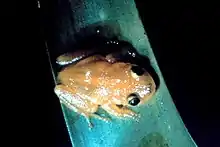Golden coquí
The golden coquí (Eleutherodactylus jasperi) is a rare species of frog endemic to Puerto Rico.[1][3]
| Golden coquí | |
|---|---|
 | |
| Scientific classification | |
| Kingdom: | Animalia |
| Phylum: | Chordata |
| Class: | Amphibia |
| Order: | Anura |
| Family: | Eleutherodactylidae |
| Genus: | Eleutherodactylus |
| Subgenus: | Eleutherodactylus |
| Species: | E. jasperi |
| Binomial name | |
| Eleutherodactylus jasperi Drewry & Jones, 1976[2] | |
General description
Golden coquís are roughly 17–22 mm (0.67–0.87 in) in snout-vent length and are olive-gold to yellow-gold without pattern. The juveniles resemble adults.[2]
The four discoverers (George E. Drewry, Kirkland L. Jones, Julia R. Clark and Jasper J. Loftus-Hills) planned to name the species for its color. However, when Dr. Loftus-Hills was killed in 1974 in an automobile accident, his colleagues chose instead to name it in his honor: jasperi.[2]
Biology
First reported to science in 1976, the golden coquí is ovoviviparous,[2] the only live-bearing species known from the family Eleutherodactylidae.[4] Female frog gives birth to 3–6 fully developed young after a pregnancy lasting less than one month.[2]
The species is restricted to a few genera of water-containing bromeliads in certain moist tropical/subtropical forests and rocky areas.[1][2]
Distribution and status
Golden coquís have only been found in areas of dense bromeliad growth in the Sierra de Cayey of Puerto Rico between 647 and 785 m above sea level. The species was last observed in 1981, and surveys of suitable habitat have not found individuals since then. However, many of the surveys have covered only historical sites and areas next to roads. Due to the apparent disappearance of the population from sites where the species was formerly found, the golden coquí is listed by the IUCN Red List as Critically Endangered[1] and by NatureServe as GH (possibly extinct). Burrowes et al. (2004)[5] presumed the golden coquí extinct. The species is listed as threatened by the United States under the Endangered Species Act.[6]
Researchers have suggested the fungal disease chytridiomycosis, in combination with climate change, as a likely cause of the species' decline. However, since no direct link has been found, and not all species are affected by the fungus, the causes for the decline are still not clear. Habitat loss to homes and agriculture is the major ongoing threat. The areas where the species was discovered have been deforested. These factors, in combination with the species' low reproductive rate, limited dispersal ability, narrow geographic range, and obligate bromeliad-dwelling existence, may be responsible for the species' precarious existence, if not its outright extinction. The species' range includes privately owned land and one protected area, the Carite Forest Reserve. Additional surveys are required to determine if golden coquís survive.
See also
- List of amphibians and reptiles of Puerto Rico
- Fauna of Puerto Rico
- List of endemic fauna of Puerto Rico
Notes
- Ariadne Angulo (2010). "Eleutherodactylus jasperi". IUCN Red List of Threatened Species. 2010: e.T7142A12829636. doi:10.2305/IUCN.UK.2010-2.RLTS.T7142A12829636.en.
- Drewry, G.E.; Jones, K. (1976). "A new ovoviviparous frog, Eleutherodactylus jasperi (Amphibia, Anura, Leptodactylidae) from Puerto Rico". Journal of Herpetology. 10: 161–165. doi:10.2307/1562976. JSTOR 1562976.
- Frost, Darrel R. (2014). "Eleutherodactylus jasperi Drewry and Jones, 1976". Amphibian Species of the World: an Online Reference. Version 6.0. American Museum of Natural History. Retrieved 23 April 2014.
- Hedges, S. B.; Duellman, W. E. & Heinicke, M. P. (2008). "New World direct-developing frogs (Anura: Terrarana): Molecular phylogeny, classification, biogeography, and conservation" (PDF). Zootaxa. 1737: 1–182.
- Burrowes, P. A., R. L. Joglar, and D. E. Green. 2004. Potential causes for amphibian declines in Puerto Rico. Herpetologica 60:141-154.
- US Fish and Wildlife Service. 1984. Recovery plan for the golden coqui (Eleutherodactylus jasperi). US Fish and Wildlife Service, Atlanta, Ga. 12pp.
